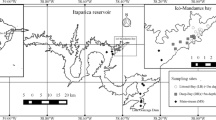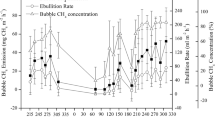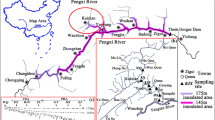Abstract
The emission of CO2 and CH4 by diffusion, bubbling and downstream was measured in ten reservoirs representative of the diversity of French hydropower reservoirs in 2016. In all reservoirs, higher fluxes were measured in summer than in spring and winter. Low fluxes were measured in alpine reservoirs as compared to run-of-the-river and storage reservoirs. The low temperatures as well as the low organic matter input from the watershed explained this observation. Bubbling was higher in run-of-the-river reservoirs, as compared to storage reservoirs. This was related to a higher ratio between the length of wooded river network in the watershed, and the reservoir surface area. This ratio was considered as a proxy for allochthonous particulate organic matter input per reservoir surface unit and its accumulation in the sediments. In the larger storage reservoirs, this preferential sedimentation area was limited to the river-reservoir transition zone, the extent of which is primarily a function of reservoir hydrodynamic and morphological parameters. Conversely, the long water residence time in deep storage reservoirs favoured greenhouse gas (GHG) accumulation in the bottom water and diffusion and downstream pathways as compared to bubbling. Classical drivers of GHG emissions in large reservoirs partly failed to explain our measurements, especially for bubbling which seemed to be primarily controlled by allochthonous particulate organic matter input per reservoir surface area. This may results from the small size and the large diversity of the studied reservoirs as compared to the larger systems classically used for global estimates.







Similar content being viewed by others
References
Abril G, Guérin F, Richard S, Delmas R, Galy-Lacaux C, Gosse P, Tremblay A, Varfalvy L, Santos Dos MA, Matvienko B (2005) Carbon dioxide and methane emissions and the carbon budget of a 10-year old tropical reservoir (Petit Saut, French Guiana). Global Biogeochem Cycles 19:GB4007. https://doi.org/10.1029/2005GB002457
Baier P, Martinot J, Rivet A (1984) Typologie écologique des lacs de haute altitude du Parc National de la Vanoise en vue de leur gestion. Etude du phytoplancton. Trav Sci Parc Natl Vanoise 14:61–108
Barros N, Cole JJ, Tranvik LJ, Prairie YT, Bastviken D, Huszar VLM, Del Giorgio P, Roland F (2011) Carbon emission from hydroelectric reservoirs linked to reservoir age and latitude. Nat Geosci 4:593–596
Bastviken D, Cole L, Pace M, Tranvik L (2004) Methane emissions from lakes: dependence of lake characteristics, two regional assessments, and a global estimate. Global Biogeochem Cycles, 18:B4009. https://doi.org/10.1029/2004GB002238
Bastviken D, Tranvik LJ, Downing JA, Crill PM, Enrich-Prast A (2011) Freshwater methane emissions offset the continental carbon sink. Science 331:50–50
Beaulieu JI, Shuster WD, Rebholz JA (2010) Nitrous oxide emissions from a large, impounded river: the Ohio River. Environ Sci Technol 44:7527–7533
Beaulieu JJ, Smolenski RL, Nietch CT, Townsend-Small A, Elovitz MS (2014) High methane emissions from a mid latitude reservoir draining an agricultural watershed. Environ Sci Technol 48:11100–11108
Beaulieu JJ, Nietch CT, Young JL (2015) Controls on nitrous oxide production and consumption in reservoirs of the Ohio River basin. J Geophys Res Biogeosci 120:1995–2010
Borges AV, Darchambeau F, Teodoru CR, Marwick TR, Tamooh F, Geeraert N, Omengo FO, Guerin F, Lambert T, Morana C, Okuku E (2015) Globally significant greenhouse-gas emissions from African inland waters. Nat Geosci 8:637–642
Burns NM, Rosa F (1980) In situ measurement of the settling velocity of organic carbon particles and 10 species of phytoplankton. Limnol Oceanogr 25:855–864
Cole JJ, Prairie YT, Caraco NF, McDowell WH, Tranvik LJ, Striegl RG, Melack J (2007) Plumbing the global carbon cycle: integrating inland waters into the terrestrial carbon budget. Ecosystems 10:172–185
Deemer BR, Harrison JA, Li S, Beaulieu JJ, DelSontro T, Barros N, Vonk JA (2016) Greenhouse gas emissions from reservoir water surfaces: a new global synthesis. Bioscience 66:949–964
DelSontro T, McGinnis DF, Sobek S, Ostrovsky I, Wehrli B (2010) Extreme methane emissions from a Swiss hydropower reservoir: contribution from bubbling sediments. Environ Sci Technol 447:2419–2425
Demarty M, Bastien J, Tremblay A, Hesslein RH, Gill R (2009) Greenhouse gas emissions from boreal reservoirs in Manitoba and Québec Canada measured with automated systems. Environ Sci Technol 43:8908–8915
Descloux S, Chanudet V, Serça D, Guérin F (2017) Methane and nitrous oxide annual emissions from an old eutrophic temperate reservoir. Sci Total Environ 598:959–972
Deshmukh C, Serça D, Delon C, Tardif R, Demarty M, Jarnot C, Meyerfeld Y, Chanudet V, Guédant P, Rode W, Descloux S, Guérin F (2014) Physical controls on CH4 emissions from a newly flooded subtropical freshwater hydroelectric reservoir: Nam Theun 2. Biogeosciences 11:4251–4269
Diem T, Koch S, Schwarzenbach S, Wehrli B, Schubert CJ (2012) Greenhouse gas emissions CO2 CH4 and N2O from several perialpine and alpine hydropower reservoirs by diffusion and loss in turbines. Aquat Sci 4:619–635
Downing JA (2010) Emerging global role of small lakes and ponds: little things mean a lot. Limnetica 29:9–24
Duchemin E, Lucotte M, Canuel R, Chamberland A (1995) Production of the greenhouse gases CH4 and CO2 by hydroelectric reservoirs of the boreal region. Global Biogeochem Cycles 9:529–540
Grinham A, Dunbabin M, Gale D, Udy J (2011) Quantification of ebullitive and diffusive methane release to atmosphere from a water storage. Atmos Environ 45:7166–7173
Guérin F, Abril G, Serça D, Delon C, Richard D, Tremblay R, Varfalvy A (2007) Gas transfer velocities of CO2 and CH4 in a tropical reservoir and its river downstream. J Mar Syst 66:161–172
Guérin F, Deshmukh C, Labat D, Pighini S, Vongkhamsao A, Guédant P, Rode W, Godon A, Chanudet V, Descloux S, Serça D (2016) Effect of sporadic destratification seasonal overturn and artificial mixing on CH4 emissions from a subtropical hydroelectric reservoir. Biogeosciences 13:3647–3663
Holgerson MA, Raymond PA (2016) Large contribution to inland water CO2 and CH4 emissions from very small ponds. Nat Geosci 9:222
Hoover TM, Marczak LB, Richardson JS, Yonemitsu N (2010) Transport and settlement of organic matter in small streams. Freshw Biol 55:436–449
Huttunen JT, Väisänen TS, Hellsten SK, Heikkikinen M, Nykänen H, Jungner H, Niskanen A, Virtanen MO, Lindqvist OV, Nenonen O, Martikainen PJ (2002) Fluxes of CH4 CO2 and N2O in hydroelectric reservoirs Lokka and Porttipahta in the northern boreal zone in Finland. Glob Biogeochem Cycles 16:1–17
Keller M, Stallard RF (1994) Methane emission by bubbling from Gatun Lake, Panama. J Geophys Res 99:8307–8319
Larsen DP, Mercier HT (1976) Phosphorus retention capacity of lakes. J Fish Board Can 33:1742–1750
Lehner B, Liermann CR, Revenga C, Vörösmarty C, Fekete B, Crouzet P, Nilsson C (2011) High-resolution mapping of the world’s reservoirs and dams for sustainable river-flow management. Front Ecol Environ 9:494–502
Maeck A, DelSontro T, McGinnis DF, Fischer H, Flury S, Schmidt M, Fietzek P, Lorke A (2013) Sediment trapping by dams creates methane emission hot spots. Environ Sci Technol 47:8130–8137
McGinnis DF, Greinert J, Artemov Y, Beaubien SE, Wüest ANDA (2006) Fate of rising methane bubbles in stratified waters: how much methane reaches the atmosphere? J Geophys Res Oceans 111:C9
Montanarella L (2004) Towards an alpine soil information system. In: Briefing papers of the 3rd Soil Conservation And Protection for Europe (SCAPE) workshop in Schruns (Austria), pp 87–96
Musenze RS, Grinham A, Werner U, Gale D, Sturm K, Udy J, Yuan Z (2014) Assessing the spatial and temporal variability of diffusive methane and nitrous oxide emissions from subtropical freshwater reservoirs. Environ Sci Technol 48:14499–14507
Pacheco FS, Soares MCS, Assireu AT, Curtarelli MP, Roland F, Abril G, Stech JL, Alvalá PC, Ometto JP (2015) The effects of river inflow and retention time on the spatial heterogeneity of chlorophyll and water-air CO2 fluxes in a tropical hydropower reservoir. Biogeosciences 12:147–162
Prairie YT, Alm J, Harby A, Mercier-Blais S, Nahas R (2017) The GHG reservoir tool (G-res) technical documentation UNESCO/IHA research project on the GHG status of freshwater reservoirs. Version 1.12. Joint publication of the UNESCO chair in global environmental change and the international hydropower association. p 76
Prairie YT, Alm J, Beaulieu J, Barros N, Battin T, Cole J, del Giorgio P, DelSontro T, Guérin F, Harby A, Harrison J, Mercier-Blais S, Serça D, Sobek S, Vachon D (2018) Greenhouse gas emissions from freshwater reservoirs: what does the atmosphere see? Ecosystems 21:1058–1071
Raymond PA, Hartmann J, Lauerwald R, Sobek S, McDonald C, Hoover M, Butman D, Striegl R, Mayorga E, Humborg C, Kortelainen P, Dürr H, Meybeck M, Ciais P, Guth P (2013) Global carbon dioxide emissions from inland waters. Nature 503:355
Sobek S, DelSontro T, Wongfun N, Wehrli B (2012) Extreme organic carbon burial fuels intense methane bubbling in a temperate reservoir. Geophys Res Lett 39:L01401. https://doi.org/10.1029/2011GL050144
St. Louis VL, Kelly CA, Duchemin E, Rudd JWM, Rosenberg DM (2000) Reservoir surfaces as sources of greenhouse gases to the atmosphere: a global estimate. Bioscience 50:766–775
Tremblay A, Varfalvy L, Garneau M, Roehm C (2005) Greenhouse gas emissions-fluxes and processes: hydroelectric reservoirs and natural environments. Springer Science and Business Media, Berlin, Heidelberg
Valette L, Piffady J, Chandesris A, Souchon Y (2012) SYRAH-CE: description des données et modélisation du risque d’altération de l’hydromorphologie des cours d’eau pour l’Etat des lieux DCE. Rapp Tech Onema-Irstea Lyon, p 104
Vollenweider RA, Kerekes J (1982) Eutrophication of waters. Monitoring assessment and control. Organization for Economic Co-Operation and Development (OECD), Paris
Wanninkhof R (1992) Relationship between wind speed and gas exchange over the ocean. J Geophys Res Oceans 97:7373–7382
Weyhenmeyer GA, Kosten S, Wallin MB, Tranvik LJ, Jeppesen E, Roland F (2015) Significant fraction of CO2 emissions from boreal lakes derived from hydrologic inorganic carbon inputs. Nat Geosci 8:933
Yvon-Durocher G, Caffrey JM, Cescatti A, Dossena M, del Giorgio P, Gasol JM, Montoya JM, Pumpanen J, Staehr PA, Trimmer M, Woodward G, Allen AP (2012) Reconciling the temperature dependence of respiration across timescales and ecosystem types. Nature 487:472
Acknowledgements
The authors are grateful to people from EDF who helped us for the selection of the reservoirs (operational constraints), for accessing the reservoirs or during the drafting of the manuscript: Benoit Peccol, Caroline Kerjean, Fabian Goeury, Georges Denise, Géraldine Duvochel, Guy Rouge, Isabelle Dubien, Isabelle Pain, Jean Copreaux, Julien Hacquard, Julien Julhes, Juliette Vetier, Laura Guitteny, Laurent Coudert, Ludovic Barthélemy, Marine Joly-Kermarec, Matthieu Vachon, Pierre Fiot, Pierre Yves Boesch, Rémy Dorget, Sébastien Farge, Thierry Benarous, Tim Kestens and Yvan Samouillet. We also thank Agnès Barillier and Frederick Jacob (also from EDF) for our interesting discussions, Jerôme Condette for GIS calculations, Jean-Noel Avrillier and Anne Millery for their help during field campaigns and analysis. Finally, we are grateful to John Harrison who thoroughly read and improved the paper. This work was supported by EDF. Funding was provided by Électricité de France.
Author information
Authors and Affiliations
Corresponding author
Additional information
Publisher's Note
Springer Nature remains neutral with regard to jurisdictional claims in published maps and institutional affiliations.
Electronic supplementary material
Below is the link to the electronic supplementary material.
Rights and permissions
About this article
Cite this article
Chanudet, V., Gaillard, J., Lambelain, J. et al. Emission of greenhouse gases from French temperate hydropower reservoirs. Aquat Sci 82, 51 (2020). https://doi.org/10.1007/s00027-020-00721-3
Received:
Accepted:
Published:
DOI: https://doi.org/10.1007/s00027-020-00721-3




